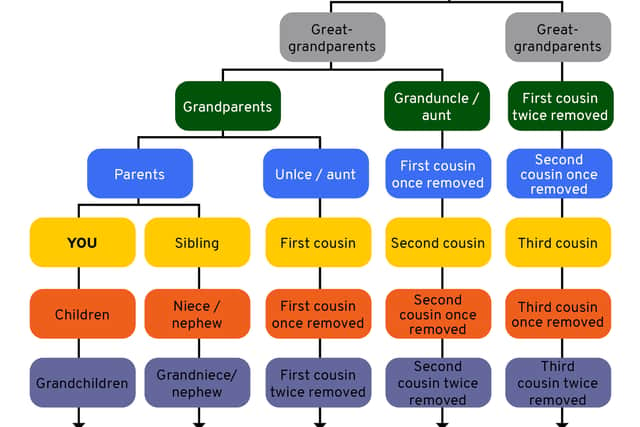What does next of kin mean? Family relationships, connections and terminology explained
and live on Freeview channel 276
Families come in all shapes and sizes. Some have children, some are childfree, some have two sets of grandparents while others may have four or even none. Some also have step relatives and others have half relatives.
There are countless ways a family unit can be built, but no matter what your one looks like there are common terms which are used to help explain the various connections people have to you. Some, like a parent, are self-explanatory, but the terms can get a bit more complicated the further out in your extended family you get - such as a cousin once removed, or the further apart the generations get - for example a great great grandparent.
Advertisement
Hide AdAdvertisement
Hide AdBeing related to someone simply means you are connected to them, usually by birth, adoption, marriage or romantic relationships. In genealogy, which is the study of families and family history, kinship terms like sibling, parent, grandparent, first cousin, and half relation describe how two specific people within a larger family tree are linked to each other. Everyone also has a next of kin, but just who that is depends on exactly what connections you have and where in the world you live.
So, to avoid any confusion, here is our handy guide on family connections and the meaning of terminology and phrases commonly used to describe them, such as next of kin.
What does next of kin mean?
Broadly speaking, a person’s next of kin is their closest relation - but there is a difference in approach to it in the United Kingdom and in the United States. In the UK, there is no legal definition which dictates who a person’s next of kin should be - and they have no power at all. In fact, “as far as the law is concerned next of kin means nothing,” according to Howells Solicitors.
People can name anyone they wish as their next of kin, however, and the title in practice means that this is the person who will be contacted in the case of an emergency or if important information needs to be communicated about someone. For most people in the UK, their next of kin is their spouse, partner or parent, but some people instead choose their sibling or a friend. It’s also possible to choose more than one next of kin.
Advertisement
Hide AdAdvertisement
Hide AdIn the US, exactly who is a person’s next of kin is determined by state statute so this can be different in each of the 50 states. Generally speaking, however, a person’s next of kin is their closest living blood relative or legal relative, including their spouse or adopted family members, according to the Cornell Law School in America. In law, a person’s next of kin is prioritised when it comes to inheritance being given from a person’s estate.


What are the terms to explain family connections?
Everyone has ancestors, and these are people they descend from. Each person descends from their parents, who also descend from their parents, who descend from their parents, and so on. This chain explains a person’s ancestry and where they come from.
For this guide, we have written about biological relationships where a man and woman have a child together and become mother and father, or mum and dad. That child could then have the following relations:
Full sibling: Another child born of the same parents is a full brother or sister.
Advertisement
Hide AdAdvertisement
Hide AdHalf sibling: A child who shares one parent, but also has one different parent, is called a half brother or sister because only half the biological parentage is the same.
Grandparents: The parents of the child’s mother and father are the child’s grandparents, a grandmother and grandfather. Other words used to describe this relationship across the UK include nan, nanny, gran, granny, grandma, papa, grandad, grampa and grandpa.
Great grandparents: The parents of a child’s grandparents are known as great grandparents.
Great great grandparents: The parents of a child’s great grandparents are called great great grandparents. When discussing family relationships, the word great means that someone is at least three generations apart from a person. It’s typical to add an extra great to the relationship term to identify just how many generations away one person is from another.


Advertisement
Hide AdAdvertisement
Hide AdAuntie: An auntie is the sister of a child’s mother or father. This is a connection that can also be given through marriage to the brother of a child’s parents.
Uncle: An uncle is the brother of a child’s mother or father. In similarity to being an auntie, being an uncle can also be earned through marrying into a family.
First cousin: A first cousin is the child of a person’s auntie and uncle. They share the same grandparents.
Second cousin: If first cousins each have children, then those children are second cousins to each other. They share a set of great-grandparents.
Advertisement
Hide AdAdvertisement
Hide AdThird cousin: If second cousins also have children, then their sons and daughters are third cousins to each other because they have the same set of great great grandparents.
Nephew: A nephew is the son of a person’s sibling.
Niece: A niece is the daughter of a person’s sibling.
Other grand relations: In terms of family relationships, the word grand relates to people who are two generations away from you. The most common of these is grandparents, but it is also possible to have a grand uncle or grand auntie. For example, a grand uncle would be a brother of a child’s grandparent, and their mother or father’s uncle, and then that child would be a grand niece or grand nephew to the grand uncle.
The term ‘grand’ is also applied in the same way in relation to people in your family who are born in two generations after you. So, the children of a person’s son or daughter are their grandchildren - specifically either grandson or granddaughter.
Other great relations: Great relations are people who are three generations away from you, so the naming of these relationships works in exactly the same way as the grand relationships explained above. A child’s great uncle, for example, would be their great grandparent’s brother, their grandmother or grandfather’s uncle, and their mother or father’s grand uncle. In turn, that child would become a great niece or nephew to the great uncle. The children of a person’s grandson or granddaughter are also known as great grandchildren.
Advertisement
Hide AdAdvertisement
Hide AdOther great great relations: Great great relations, or any even further away from a person than that such as great great great relations and so on, also have the same links and terminology conventions used as described above.
Other half relations: Any other half relationships within the family come from a half sibling relationship. If a child has a half sibling then anyone who is related to them through that person is also a half relation. For example, the child of a person’s half sibling would be a half niece or nephew. The children of half siblings are also half cousins to each other.
Step relations: A step relation is someone who has entered in to the family by remarriage or a second relationship, but is not biologically related to anyone. So, for example, if a couple have a child but then have split up and each marry a new person then their new partners will become a stepmum or stepdad to their child. Similarly, if grandparents are no longer in a relationship but they are also with someone else that person will become a step grandmother or step grandfather - and this is how a child could end up with four sets of grandparents.
Removed relations: Removed relations refer to the relationships between cousins, and their children, who are from different generations. A cousin can also be once, twice or more, depending on how many generations apart cousins are. If a person’s first cousin has a child, for example, then their child would be first cousin once removed to them. A cousin who is one generation older than a person is also described once removed, or higher according to the same pattern. The first cousin of a child’s parents, for instance, is that child’s first cousin once removed.
Comment Guidelines
National World encourages reader discussion on our stories. User feedback, insights and back-and-forth exchanges add a rich layer of context to reporting. Please review our Community Guidelines before commenting.
